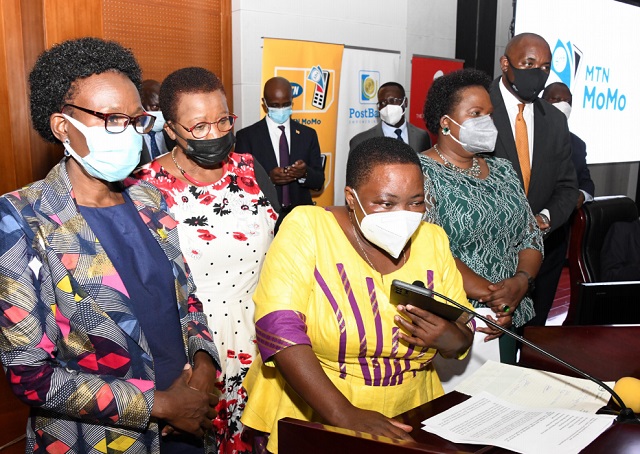
Mobile cash and her changes in PM office
Kampala, Uganda | JOSEPH WERE | Debonair. Reticent. Uganda has recently had two very different prime ministers personality-wise; Amama Mbabazi and Ruhakana Rugunda. It is up to you to tick who of the two was debonair and who was reticent.
Now the country has a new Prime Minister, Robinah Nabbanja, who appears to have a totally different personality. Rambunctious might describe her well. And she wears it on her lapel like a badge of honour.
Bubbly, plumb, and endowed with a beguiling humility, Nabbanja is the quintessential endomorph; apparently fun-loving and good humoured. But as recent events show, it appears, the relaxed exterior belies an inner will of steel.
Take the events leading to and on July 8 when the new prime minister launched the mobile money COVID relief cash.
Nabbanja personally sampled the first recipients. And some of the exchanges were entertaining.
“Hallo,” she said, “This is the prime minister of Uganda. I am trying to confirm. Have you seen anything happen on your phone?
“I am seeing Shs102, 425,” was the reply.
Nabbanja: “What is your name?”
I am Dennis Okumu Ojok
Nabbanja: What do you do?
Okumu: “I am a farmer”. (Wrong answer!)
Nabbanja: “What else do you do?”
Okumu: “I am a bodaboda rider in Gulu town” (Right answer).
Nabbanja: Oh, Ok.
All the while, after each successful call, a bubbly almost all-female group of leaders in the Ministry of Health clapped, cheered, and ululated like a bunch of nursery school kids. It was a lovely and until now unseen side of Health Minister Jane Ruth Aceng, and her junior minister; Hanifah Kawooya and the Minister of Gender, Betty Amongi.
But getting the Shs100, 000 (Approx. US$28) to vulnerable people who lost livelihoods due the COVID-19 lockdown imposed on June 07 had not been easy.
While announcing the second lockdown to control the spread of Covid-19, President Yoweri Museveni said that his government was going to support vulnerable people whose income was interrupted by the lockdown. He also said, instead of giving maize flour and beans to vulnerable people as it did in the first lockdown, the government would this time give each beneficiary Shs100, 000 via their mobile phone numbers.
Museveni’s announcement sparked a flurry of pro-and counter arguments. The dominant view sometimes appeared to be that it was impossible to accurately send money to actual vulnerable people. Many claimed the Shs56 billion set aside to go to about 500,000 recipients would be swindled. Nabbanja’s name became a meme for a botched project on social media.
It almost turned ugly when, with just one day to the event, the Minister of State for Gender, Charles Okello Engola, told parliament that sending the COVID-19 relief would delay for another week. And even after Minister Amongi, quickly quashed talk of any delay, doubt persisted. That possibly explains why there was so much excitement when the first recipients actually got the money. Rarely do Ugandans see ministers so excited to be giving a helping hand to the most vulnerable.
Speed matters
A lot was riding on this single programme, of passing on the Shs100, 000 to about 500,000 of the most vulnerable people.
As The Independent has reported earlier (See: “Mobile money cash for COVID-19 poor: Why Nabbanja is right and others wrong” The Independent July 02), the Shs100, 000 given to the poorest was a tiny but important cog in the government’s effort to stimulate the economy and avoid it sinking into a recession.
Already, the international financial agencies are projecting that Uganda’s Real Gross Domestic Product (GDP) growth will fall to a range of 3% to 3.31% in FY 2020/21 from 6.5 percent in FY2019/2020 and approximately 780,000 Ugandans could be pushed into poverty. Hard hit sectors include education, information services, tourism, entertainment and construction and manufacturing.
In a bid to stem further erosion, the government for FY 2020/21 has mobilized resources from International Financial Institutions (IFIs) and domestic resources to stimulate the economy. It has allocated approximately Shs1.3 trillion towards the recapitalization of three major financial institutions; Shs1 trillion into the Uganda Development Bank, Shs138 billion in the Uganda Development Corporation, and Shs94 billion in the Microfinance Support Centre. About Shs1 trillion of this money came from the World Bank, Shs1.9 trillion equivalent from the International Monetary Fund (IMF), and Shs26 billion from the European Union (EU).The government wants this money lent to businesses to stay afloat.
But Economists and policy makers also say government relief support to vulnerable consumers is also important in curbing and economic recession and accelerating recovery. That successful government relief programmes should have three general features; it must be quickly implementable and its effect swiftly felt, it should put money in hands of people who are going to spend it and businesses most in need, and it should not become a habit as this creates long-run fiscal burden.
That is where Nabbanja’s Shs100, 000 to the most vulnerable comes in. There were voices in parliament that said the relief money should be increased to something around Shs250, 000.
But experts say this could easily defeat the objective of the stimulus and unnecessarily increase the fiscal burden on the government. As Nabbanja told the first recipients of the money, the government wants them to “buy food not beer.”
 The Independent Uganda: You get the Truth we Pay the Price
The Independent Uganda: You get the Truth we Pay the Price


